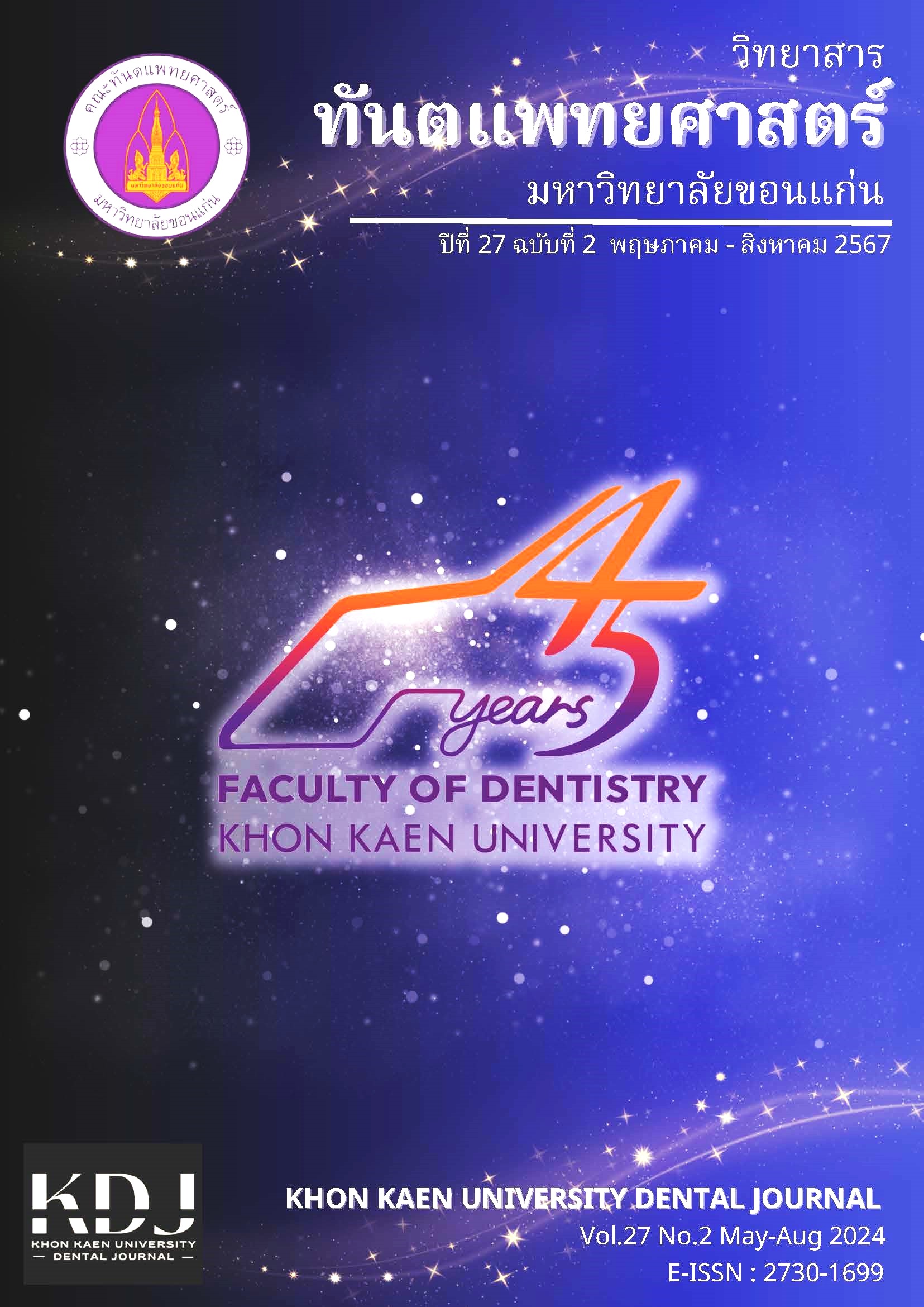Comparison of the Mandibular Foramen Position in Panoramic Radiographs in Skeletal Class I, II and III
Main Article Content
Abstract
The position of the mandibular foramen can vary depending on age, gender, ethnicity, and skeletal patterns. Knowing the position of the mandibular foramen before performing oral surgery procedures can help reduce the incidence of complications or adverse events. The purpose of the study was to compare the position of the mandibular foramen and investigate its correlation with the gonial angle across different skeletal patterns. This was a retrospective analytical cross-sectional study. All data (91 subjects) were collected and analyzed from lateral cephalometric and panoramic radiographs. Statistical analysis revealed no significant difference in mandibular foramen position among skeletal classes I, II, and III in males (p>0.05). However, in females, a significant relationship was observed. Specifically, in skeletal class I, the distance from the mandibular foramen to the anterior ramus (M-A) was greater than in class III (p<0.05), and distance from the mandibular foramen to the posterior border of the ramus (M-P) was greater than in class II (p<0.05). Furthermore, a negative correlation between the distance from the mandibular foramen to the occlusal plane (M-O) and the gonial angle was found in skeletal class III (B = -1.31, p<0.05). In conclusion, for females with skeletal Class I, the M-A distance is greater compared to Class II and III. Successful outcomes in inferior alveolar nerve blocks require deeper needle insertion compared to Class II and III.
Article Details

This work is licensed under a Creative Commons Attribution-NonCommercial-NoDerivatives 4.0 International License.
บทความ ข้อมูล เนื้อหา รูปภาพ ฯลฯ ที่ได้รับการลงตีพิมพ์ในวิทยาสารทันตแพทยศาสตร์ มหาวิทยาลัยขอนแก่นถือเป็นลิขสิทธิ์เฉพาะของคณะทันตแพทยศาสตร์ มหาวิทยาลัยขอนแก่น หากบุคคลหรือหน่วยงานใดต้องการนำทั้งหมดหรือส่วนหนึ่งส่วนใดไปเผยแพร่ต่อหรือเพื่อกระทำการใด ๆ จะต้องได้รับอนุญาตเป็นลายลักษณ์อักษร จากคณะทันตแพทยศาสตร์ มหาวิทยาลัยขอนแก่นก่อนเท่านั้น
References
Khalil H. A basic review on the inferior alveolar nerve block techniques. Anesth Essays Res 2014;8(1):3–8.
Shalini R, RaviVarman C, Manoranjitham R, Veeramuthu M. Morphometric study on mandibular foramen and incidence of accessory mandibular foramen in mandibles of south Indian population and its clinical implications in inferior alveolar nerve block. Anat Cell Biol 2016; 49(4):241-8.
Kaffe I, Ardekian L, Gelerenter I, Taicher S. Location of the mandibular foramen in panoramic radiographs. Oral Surg Oral Med Oral Pathol 1994;78(5):662-9.
Kositbowornchai S, Siritapetawee M, Damrongrungruang T, Khongkankong W, Chatrchaiwiwatana S, Khamanarong K, et al. Shape of the lingula and its localization by panoramic radiograph versus dry mandibular measurement. Surg Radiol Anat 2007;29(8):689-94.
da Fontoura RA, Vasconcellos HA, Campos AES. Morphologic basis for the intraoral vertical ramus osteotomy: anatomic and radiographic localization of the mandibular foramen. J Oral Maxillofac Surg 2002; 60(6):660-5.
Bhullar MK, Uppal AS, Kochhar GK, Chachra S, Kochhar AS. Comparison of gonial angle determination from cephalograms and orthopantomogram. Indian J Dent 2014;5(3):123.
Radhakrishnan PD, Varma NKS, Ajith VV. Dilemma of gonial angle measurement: Panoramic radiograph or lateral cephalogram. Imaging Sci Dent 2017;47(2):93-7.
Zangouei-Booshehri M, Aghili H-A, Abasi M, Ezoddini-Ardakani F. Agreement between panoramic and lateral cephalometric radiographs for measuring the gonial angle. Iran J Radiol 2012;9(4):178.
Alves N, Deana NF. Morphometric study of mandibular foramen in macerated skulls to contribute to the development of sagittal split ramus osteotomy (SSRO) technique. Surg Radiol Anat 2014;36(9):839-45.
Hwang T, Hsu S, Huang Q, Guo M. Age changes in location of mandibular foramen. Zhonghua Ya Yi Xue Hui Za Zhi 1990;9(3):98-103.
Kajan ZD, Sigaroudi AK, Khosravifard N, Farsam N. Comparison of the Mandibular Foramen Position Among Different Skeletal Classes Using Panoramic Radiographs. Iran J Orthod 2019;14(1):1-6.
Park HS, Lee JH. A comparative study on the location of the mandibular foramen in CBCT of normal occlusion and skeletal class II and III malocclusion. Maxillofac Plast Reconstr Surg 2015;37(1):25.
Nonprasert T, Hirunnopcharoen T, Limmonthol S, Tuamsuk P, Sutthiprapaporn P, Weraarchakul W, et al. The correlation between the location of mandibular foramen and the gonial angle. Khon Kaen Dent J 2019;22(1):43-52.
Gabriel AC. Some anatomical features of the mandible. J Anat 1958;92(4):580.
Singh S, Mishra S, Kumar P, Sinha P. Sushobhana; Passey, J. & Singh, R. Location of mandibular foramen in correlation with the gonial angle in indian population: A morphometric study for surgical practices. Int J Anat Res 2015;3(3):1345-50.
Sutthiprapaporn P, Pisek A, Manosudprasit M, Pisek P, Phaoseree N, Manosudprasit A. Establishing Esthetic Lateral Cephalometric Values for Thai Adults after Orthodontic Treatment. Khon Kaen Dent J 2020;23(2):31-41.


